Khangla & Thorang passes trek

Nar Phu, located in the isolated corner of restricted part of Annapurna between Damodar Kunda and Annapurna Circuit part one. The area is untouched of modernity and where people adopting Tibetan culture since many centuries back. This off the beaten track trek from Annapurna offers real taste of Himalayan life style, culture, tradition, old Buddhist monasteries, and explore an untouched valley which offers an incredible view of majestic mountains in the high lands along with beautiful medieval and ancient remote villages such as Nar and Phu, amazing rock formations, glaciers, narrow canyons, lovely and pleasant forests, unique Himalayan and Tibetan culture, life styles, and high altitude settlements.
Nar Phu predominantly lies in Manang district of Gandaki Zone. In the beginnings we have follow the Annapurna Circuit trail part one till Koto. Nar Phu valley is contracted and forested, the valley opens up to a vast area of high snow-topped peaks, prehistoric villages and high elevated grazing lands. Very minority number of tourists has walked around this region. While trekking to this occasionally trekked trail we will be camping along the way to Nar and Phu, or we will be oraganizing home stay trip to experience and interact with locals. We visit some of the virgin and attractive villages of the Tibetan Buddhist. Buddhist pilgrims probably makes visit to Phu in order to visit the well-known monastery, Tashi Lha Khang and get a blessing from Lama.
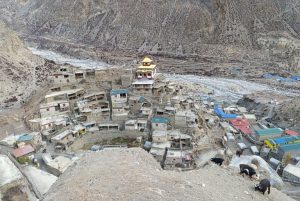
Naar Phu Trek rewards you with the total wilderness experience and unexplored Tibetan villages just opened for the outsider only since 2003. This trek takes you to the exotic valley that is in the far-off corner of the Annapurna region. The Naar Phu valley remains untouched by modernity. Trekking in the area is unlike most of Nepal as the terrain is Trans Himalayan and similar to that of Tibet.
The trail is still rugged and the people and culture has remained intact. Special trekking permit is required to visit this place. After a couple days of exploration of the valley, we cross over Kang La Pass 5322m on the way to Manang. We join the main trekking trail to Annapurna Round Trek following the best trekking route of Thorong La Pass 5416m. Obviously, this remote and rugged trail offers challenging and exhilarating trekking experience for adventure enthusiasts. With, Wilderness Excursion Pvt. Ltd, you can explore Nar Phu Valley Trek and observe incredible views of the Annapurna massif, Machhapuchhre Himal, Lamjung Himal, Manaslu Himal, Tilicho peak, Dhaulagiri range and several other snow-capped peaks.
For your kind information, Nar Phu trek requires restricted area permit which is US$ 90 per week per person and December – August US$ 75 per week per person or equivalent convertible foreign currency. In addition, ACAP Permit is mandatory that cost NPR. 2000.00 Per person. You must trek with a licensed guide and arrange with a government registered trekking agency. We organize budget trip to Nar Phu valley in most completive price and offer you tailor-made itinerary that meets your need. And this trek can also be combined with challenging passes crossing through Masokanto La (5099m.), Tilicho Pass (5230m.) and most thrilling Saribung Pass (6020m) Trek but trek through these high passes will be fully camping except via Thorong La pass.
NOTE: During the trip; weather, local politics, transport or a multitude of other factors, that are beyond our control can result in a change of itinerary. It is, however, very unlikely that the itinerary would be substantially altered; if alterations are necessary the leader will decide what is the best alternative, taking into consideration the best interests of the whole group. Where a change does occur, we do everything we can to minimize its effect, but we cannot be responsible for the results of changes or delays.
Flight Delay in Kathmandu and Lukla
Twin Otter is the primary mode of transport to and from the airstrip at Lukla. This service is fairly dependable. Sometimes, flights (to and from Lukla) may be cancelled due to mountain weather conditions or technical problems. In such case, Himalayan Trail Blazer will charter a helicopter to ensure you are on schedule for your international flight. The helicopter can fly if the visibility is 1500m, while the twin otter can fly if the visibility is 5000m, as per Nepal’s Civil Aviation rules.
The cost of the helicopter is payable directly to our Kathmandu office in the event that this service is utilized. US cash, traveler’s cheques, or credit cards (Visa Cards, Master Cards only) are accepted. You will be given a receipt upon payment so that you may claim the amount from your travel insurance. The minimum cost will be US$500 and maximum US$3500 depending on the number of group members.
Day 1: Arrival in Kathmandu (1,300 m) – Welcome to Nepal
Arrive at Tribhuvan International Airport, where our team greets you with a warm welcome and transfers you to your hotel in Kathmandu. In the evening, enjoy a short briefing about your upcoming Naar Phu trek and get introduced to your trekking guide. The rest of the day is free to relax or explore the bustling streets of Thamel. Overnight stay in a comfortable hotel. This marks the start of your Himalayan adventure.
Day 2: Kathmandu Sightseeing Tour (1,300 m) – Cultural and Spiritual Exploration
Join a professional city guide for a full-day heritage tour of Kathmandu Valley. Visit Pashupatinath Temple, Nepal’s holiest Hindu site, and Boudhanath Stupa, the largest Buddhist monument in the country. Continue to Patan Durbar Square, a showcase of medieval architecture and fine arts. Experience Nepal’s blend of ancient spirituality and modern vibrancy. Overnight at hotel in Kathmandu.
Day 3: Drive from Kathmandu to Taal (1,700 m) – Scenic Journey to the Mountains
Start early for a scenic drive along the Prithvi Highway, following the Trishuli and Marshyangdi Rivers. Pass through lush hills, terraced fields, and small mountain villages before reaching Taal, a charming settlement by the riverside. The landscape shifts from tropical greenery to alpine surroundings as you ascend. Enjoy the serene village atmosphere and rest for the night. Overnight in Taal.
Day 4: Trek from Dharapani to Koto (2,600 m) – Gateway to Nar Phu Valley
Begin your trek from Dharapani, following forested trails and crossing suspension bridges along the Marshyangdi River. Walk past traditional stone houses and Buddhist mani walls that mark the influence of Tibetan culture. The trail offers a gradual ascent through pine and fir forests. Reach Koto, the official entry point to the restricted Nar Phu Valley. Overnight in Koto.
Day 5: Trek from Koto to Meta (3,374 m) – Entering the Hidden Valley
After registering your permits, follow the Nar River deep into the wild valley. The trail winds through narrow canyons, waterfalls, and dense forests before opening into a high alpine plateau. Meta offers the first stunning views of the Annapurna range. The temperature drops as you reach this remote settlement of simple lodges. Overnight at Meta.
Day 6: Trek from Meta to Kayang (3,740 m) – Exploring High Himalayan Landscapes
Continue your trek through barren ridges and remote valleys surrounded by snow-clad peaks. Pass through small Chortens and ancient caves that reflect the untouched beauty of the Nar Phu region. The air becomes thinner, and yak pastures appear along the trail. Enjoy the crisp mountain atmosphere and incredible panoramic views. Overnight at Kayang.
Day 7: Trek from Kayang to Phu Gaon (4,050 m) – Discovering the Ancient Fortress Village
Follow the trail to Phu Gaon, a medieval village perched above the river and surrounded by high cliffs. Pass traditional stone gateways and ancient Buddhist monasteries along the way. Phu is one of the most isolated settlements in Nepal, home to centuries-old culture and traditional Tibetan customs. The views of Himlung Himal and other peaks are mesmerizing. Overnight at Phu Gaon.
Day 8: Acclimatization Day in Phu Gaon (4,050 m) – Cultural Rest and Exploration
Spend the day resting and adjusting to the altitude while exploring this hidden Himalayan village. Visit Tashi Lhakhang Monastery, believed to be one of the last monasteries blessed by Lama Karma Rinpoche. Observe local life, interact with villagers, and witness yak herding and traditional weaving. Optional short hikes offer more views of the surrounding glaciers. Overnight at Phu Gaon.
Day 9: Trek from Phu Gaon to Nar Phedi (4,150 m) – Journey to the Sister Valley
Descend the valley before climbing toward Nar Phedi, a monastery-run stopover located below Nar Village. The route crosses rocky terrain and passes ancient Buddhist chortens. Enjoy peaceful surroundings and the hum of prayer flags fluttering in the wind. The monastery here provides warm hospitality and simple but comfortable lodging. Overnight at Nar Phedi Monastery.
Day 10: Acclimatization Day at Nar Phedi (4,150 m) – Rest and Spiritual Reflection
Take a second acclimatization day to prepare for the high pass ahead. Participate in monastery rituals or simply enjoy the quiet mountain environment. Short side hikes are available to nearby ridges for better acclimatization. The serene atmosphere allows you to recharge mentally and physically. Overnight at Nar Phedi.
Day 11: Trek from Nar Phedi to Ngawal via Kang La Pass (5,240 m / 3,660 m) – Conquering the High Pass
This is one of the most thrilling days of the trek. Start early to cross Kang La Pass (5,240 m), offering breathtaking views of Annapurna II, Gangapurna, and Tilicho Peak. The climb is steep but rewarding as you reach the windswept summit. Descend carefully to Ngawal, a picturesque village with apple orchards and warm teahouses. Overnight in Ngawal.
Day 12: Trek from Ngawal to Manang (3,540 m) – Join the Annapurna Circuit Trail
Descend gradually to Manang, one of the largest villages along the Annapurna Circuit. The trail offers beautiful views of the Marsyangdi Valley and surrounding peaks. Explore monasteries, bakeries, and local shops upon arrival. Manang is known for its rich culture and excellent trekking amenities. Overnight at Manang.
Day 13: Trek from Manang to Yak Kharka (4,050 m) – Climbing Toward Higher Pastures
Leave Manang and ascend through alpine meadows where yaks graze peacefully. The path passes stone walls, juniper shrubs, and small streams. As the air thins, the trek becomes slower but the views more dramatic. Yak Kharka provides a tranquil resting point before the Thorong La crossing. Overnight at Yak Kharka.
Day 14: Trek from Yak Kharka to Thorong Phedi (4,450 m) – Base of the Mighty Pass
A short but steep climb takes you to Thorong Phedi, the last settlement before crossing the pass. The trail follows rugged terrain and windswept cliffs. Rest early and prepare for the challenging ascent ahead. The evening offers breathtaking mountain views and a sense of anticipation. Overnight at Thorong Phedi.
Day 15: Trek from Thorong Phedi to Muktinath via Thorong La Pass (5,416 m / 3,800 m) – Crossing the World’s Highest Pass
Start before dawn for the climb to Thorong La Pass (5,416 m), the highest point of the trek. The ascent is demanding but offers panoramic views of Dhaulagiri and Annapurna ranges. After celebrating your achievement, descend to Muktinath, a sacred pilgrimage site for both Hindus and Buddhists. Visit the temple complex with eternal flame and water spouts. Overnight in Muktinath.
Day 16: Trek from Muktinath to Kagbeni (2,800 m) – Gateway to Upper Mustang
Descend along the Kali Gandaki Valley, passing ancient monasteries and windy trails. Kagbeni is a charming medieval village marking the border of Upper Mustang. Explore narrow alleys, traditional houses, and a centuries-old monastery. The village offers spectacular views of Nilgiri and the river gorge. Overnight in Kagbeni.
Day 17: Fly or Drive to Pokhara (827 m) – Rest and Relaxation by the Lakeside
After breakfast, take a scenic flight or drive to Pokhara, the city of lakes. Enjoy stunning views of the Annapurna and Dhaulagiri ranges along the way. In Pokhara, relax by Phewa Lake, stroll along the lakeside, or enjoy a café with a view. It’s the perfect place to unwind after your long trek. Overnight in Pokhara.
Day 18: Fly or Drive to Kathmandu (1,300 m) – Return to the Capital
Take a morning flight or drive back to Kathmandu, retracing the Himalayan scenery one last time. Upon arrival, transfer to your hotel for some rest or last-minute souvenir shopping. The evening can be spent enjoying a farewell Nepali dinner. Overnight stay in Kathmandu.
Day 19: Departure from Kathmandu (1,300 m) – Farewell and Reflection
Enjoy a free morning before your scheduled departure. Our representative will transfer you to the airport for your onward flight. Reflect on your incredible journey through the hidden valleys of Naar and Phu. Depart Nepal with unforgettable memories and a sense of accomplishment from your Himalayan adventure.
Cost Includes
– Airport / Hotel / Airport pick up & drop by private tourist vehicle.
– Standard twin sharing accommodation in a two or three star hotel in Kathmandu; Breakfast included. (3 nights)
– Standard twin sharing accommodation in a two or three star hotel in Pokhara; Breakfast included. (2 nights)
– Guided city tour in Kathmandu and Pokhara by private tourist vehicle.
– All your standard Meals during the trek (Breakfasts, Lunches and Dinners).
– Lodges, Guesthouses accommodation during the trek (8 nights Trekking Guesthouse in twin sharing and occasionally dormitory style).
– Local Himalayan Trail Blazer licensed English speaking guide.
– The required number of local staff and porters to carry your luggage during the trek (We assign one porter for every two guests).
– Food, accommodation, salary, insurance, equipment and medicine for all staff.
– Annapurna Conservation Park permits and TIMS permit for trekking.
– Sleeping bag by Himalayan Trail Blazer (which need to be returned after the trek).
– Surface transfer from and to Kathmandu.
– Sightseeing/Monument entrance fees in Kathmandu and Pokhara (On Day 2nd and 12th).
– Farewell dinner in typical Nepali Restaurant with cultural dance show on second last day (On Day 13th).
– All our government taxes, vat, tourist service charges.
– Official expenses.
Cost Does not Include
– Lunch and dinner whilst in Kathmandu and Pokhara.
– Travel insurance which covers emergency Rescue and Evacuation.
– International airfare and airport departure tax.
– Nepal entry visa; you can obtain a visa easily upon your arrival at Tribhuwan International Airport in Kathmandu. (Tourist Visa with Multiple Entries for 30 days can be obtained by paying US $ 40 or equivalent foreign currency. Similarly, Tourist Visa with Multiple Entries for 90 days can be obtained by paying US $ 100. Please bring 2 copies of passport size photos).
– Alcoholic, hot and cold drinks.
– Personal trekking Equipment.
– Tips for trekking staff and driver (Tipping is expected).
– Any others expenses which are not mentioned on ‘Price Includes’ section.
What type of shape do I need to be in, is this trip for me?
Annapurna base camp trek is suitable for average people who are moderately fit, thus no previous experience is required. Some physical fitness programs such as running, swimming, hiking is recommended before you embark on your journey. Persons suffering from a pre-existing medical condition must seek medical advice/consent before considering the trek. Whilst on the trek, it is common to experience some discomfort before being fully acclimatized. To prepare for trek you should begin training at least two to three months before your departure. As a guideline, an hour of aerobic exercise three to four times per week would be considered a minimum requirement. The best preparation is bushwalking involving relatively steep ascents and descents. If you can manage a couple of valley floor to ridgeline ascents per comfortable and able to enjoy the trek to the fullest. They are physically strong, sharp-witted and have an incredibly positive attitude towards a life that we would consider extremely tough. There is something about a trek in the Himalaya that draws you back time and time again. For keen walkers it is a paradise and even avowed non-walkers find that one foot just seems to follow the other, drawn by the appeal of what lies beyond.
Will somebody come to pick me up at the airport upon my arrival?
Yes, our airport representative will be there to greet you at the airport. S/he will be displaying an Himalayan Trail Blazer sign board outside the airport terminal. Upon arrival, you will be transferred to your hotel by our tourist vehicle.
What sort of accommodation can I expect in Kathmandu, Pokhara and in trekking?
Yes, our airport representative will be there to greet you at the airport. S/he will be displaying an Himalayan Trail Blazer sign board outside the airport terminal. Upon arrival, you will be transferred to your hotel by our tourist vehicle.
What sort of accommodation can I expect in Kathmandu and in trekking?
We use standard rooms at three star hotels in Kathmandu and Pokhara with breakfast included. Along the trekking routes, teahouses/lodges generally provide basic clean facilities with a mattress and a quilt or blanket. We can also offer you Himalayan Trail Blazer sleeping bags if needed (to be returned after the trip) but it is a good idea to always have your own sleeping equipment.The lodges in trekking routes usually provide single and double rooms, or occasionally a dormitory. At times when possible, dining will be around a bon fire. In tea houses, food will be prepared in the kitchen which you should not enter without permission. The toilet in tea houses provides essential and basic facilities and are always outside the room.
Is it possible to reserve a trip now and pay deposit later or do I HAVE to pay deposit at booking/reservation?
Yes! The trip will be confirmed only when we receive the completed final booking form and 30% deposit payment. You can pay the balance of the money when you arrive in Kathmandu.
Is there a possibility of getting separate rooms for the Kathmandu portion of the trip? If so how much extra will this cost?
Yes! We can surely book separate rooms in Kathmandu for your portion of the trip. During the trek we will try our best but normally the lodges have twin sharing and dormitory styled room instead of a single room. The lodges will provide a private room for one person when the room is free and additional cost is not required.
The additional cost is USD 70 per person for booking a single room in Kathmandu for four nights when booking for groups of two or more than two people. For one person the trip price of USD 1800 per person already includes a single room supplement fee.
Is this a guaranteed departure even if I am alone stating in the request trip?
YES all our trips are guaranteed to run. We never cancel the trip due to not having enough participants, we can arrange the trip for one person as well.
When I pay the remainder of the money on arrival in Kathmandu, how do you take that money? US cash or credit card?
You can clear the remainder of the money upon your arrival in Kathmandu or even before you arrive in Kathmandu. You can use USD cash, American Express, Travelers Check, Master or Visa cards for the payment options. There will be 4% bank levy when paying by credit cards.
What sort of food can I expect in trekking?
Most teahouses (lodges) in Everest Base Camp trails cook a delicious range of mostly vegetarian fare. Pasta, tuna bakes, noodles, potatoes, eggs, daal bhat(rice and lentils), bread, soup, fresh vegetables (variety depends on the season) and even some desserts like apple pies, pancakes, and some interesting attempts at custard. You will find a lot of garlic on the menu because it assists with acclimatization – eat some every day. In many larger villages you may find some meat items on the menu. You can always get hot chocolate, tea, and hot lemon drinks, as well as soft drinks, and treats like chocolate and crisps. Each day dinner and breakfast will be at a lodge you’ll stay at while lunch will be taken on the way to destination.
Is the food in mountain prepared to international standard in terms of safety?
YES, the food is very safe during the trekking and we recommend you to eat the vegetarian and local food.
Is water provided and is there still water available at higher altitudes? Is it filtered/boiled? Readily available?
Bottled water is easily available at the lodges and tea houses. You can buy bottled water at the cost of USD 2 at lower elevations to USD 4 to higher elevation per littler. You can also drink the normal tap or spring water if you bring the purifying aid with you.
What mode of transportation do you use?
Himalayan Trail Blazer is all about providing you with local insights, lifestyle as well as adventure. Depending on the nature of the travel, the transportation to and from the destination varies from domestic flights to vehicular transportation to even piggyback rides on mules and yaks. We provide you only those options which enhance your local experience while allowing you to travel comfortably and efficiently. We use private tourist vehicles for sightseeing, city tours and pickups. Depending on the group size we use cars, minibus, vans or alternatively 4WD SUVs, more maneuverable in travelling along the narrow and bumpy roads of Nepal. All the vehicles are usually air-conditioned unless we are travelling in cooler areas.
For domestic flights (Kathmandu – Lukla – Kathmandu), we use Tara Air, Agni Air -popular domestic airlines.
What is the best season for this trekking?
Every trekking trip up the mighty Mt. Everest presents its own amazing, unforgettable moments that forever live on in the hearts and minds of those brave enough to make the climb. One of the most unpredictable elements of the Everest region is the weather. If you’re not properly prepared for the twists, turns and volatility of the conditions that can occur in this breathtaking region, you might find yourself in an uncomfortable and unpleasant situation. Here are some weather basics to help ensure that you come to the Himalayas as well equipped and prepared to face anything.
Generally speaking, the nights are much cooler than the daytime hours in the Everest region. Many first-time trekkers are surprised to learn about the incredible range that may occur in a given day. During the day, the thermometer could reach temps as high as 25 degrees C, only to dip down as low as -20 degrees C in less than 24 hours. While there’s no way to know exactly what each day in the mountains will bring, the weather and temperature ranges tend to be somewhat predictable based on the month and season.
Spring – March / April / May / June
Spring happens to be one of the best times of the year to visit the Everest region, although because of this, it can become somewhat crowded. One can meet many other Everest climbers during this season and base camp is full of tents. The beautiful clear blue sky can be seen and the many different species of flower are visible in the lower altitude.
During springtime, the average temperature is 17 degrees C with a maximum of 25 degrees C during sunny days and a minimum of -15 degrees C in the morning and at night for areas above 4000 meters.
July / August Through Mid-September is Monsoon Season
This season is not really recommended to travel as it rains in the lower altitudes, below 3500 meters. In areas above 4000 meters, it rains sometimes and although it is also sometimes dry, very few people travel during this season. There are positives to trekking during the monsoon months, however. The excess rainfall can provide ample chance to see spectacular views of the waterfall and it’s also the best season to avoid the crowds. The maximum temperature during the monsoon season averages 25 degrees C during sunny days with a minimum -15 degrees C in the morning and night at areas above 4000 meters. The average temperature tends to hover around a comfortable 18 degrees C.
Autumn – End of September / October / November
Similar to springtime, autumn in the Everest region is also a crowded season, but it’s one of the best times to trek. While it lacks the beauty of flowers, the clear blue sky can be seen, affording incredible views from just about every angle.
The average temperature during the fall is 15 degrees C with a maximum temp of 20 degrees C during sunny days and a minimum of -10 degrees C in the morning and at night, for areas above 4000 meters altitude.
Regardless of time of year, trekkers should always plan accordingly and bring clothing for both cooler and warmer temps. Layering is always recommended, as are pants that can double as shorts. For a full list of clothing and materials to bring to account for various temperatures and weather changes that can occur in the Everest region, visitors should work closely with their travel provider. This will ensure that the adventure will be enjoyable no matter what the weather and that every possible scenario will be accounted for ahead of time.
I m a Vegeterain, is that a Problem ?
No problem at all because the lodges mostly serve the vegetarian meals. We always recommend our clients to eat vegetarian meals to avoid the food poisoning, eating heavy meals and non- vegetarian meals at the high altitude is not really safe for the stomach.
What is the weather and temperature like in trekking?
Lorem ipsum dolor sit amet, consectetur adipiscing elit. Ut elit tellus, luctus nec ullamcorper mattis, pulvinar dapibus leo.
Do your guides have trekking guide certificates from the Hotel Management and Tourism Center? Have they received first aid training for high altitude?
Yes, they have all received a 45-day training from the Hotel Management and Tourism Center in Nepal. The guides have also received high altitude first aid training from KEEP (Kathmandu Environmental Education Project).
What safety measures are in place? What safety equipment do your guides carry with them on trek to deal with sickness/accidents?
Lorem ipsum dolor sit amet, consectetur adipiscing elit. Ut elit tellus, luctus nec ullamcorper mattis, pulvinar dapibus leo.
Can I add extra days to my trekking trip?
Holiday should never be about making it to the final point quickly. Along your trek we can add days at your request with additional costs to cover guides, porters, accommodation and food.
What immunizations will I need?
No vaccinations are compulsory in Himalaya, but we do recommend you are covered for diphtheria & TB, hepatitis A, hepatitis B, *malaria, typhoid, polio and tetanus.
We also recommend:
A dental check-up prior to travelling.
That you know your blood group in case of emergency.
If you have any pre-existing medical conditions which might affect you on tour, you make these known to your tour leader and Himalayan Trail Blazer at the time of your booking.
Is there any communication while we are on trekking?
There are telephones in some villages along the trekking routes from which you can make international calls. All our guides are equipped with the local mobile phone. You may wish to pass the number of our guide to your family for the callback or you can make a call from the guide’s mobile and pay him directly for the international call too.
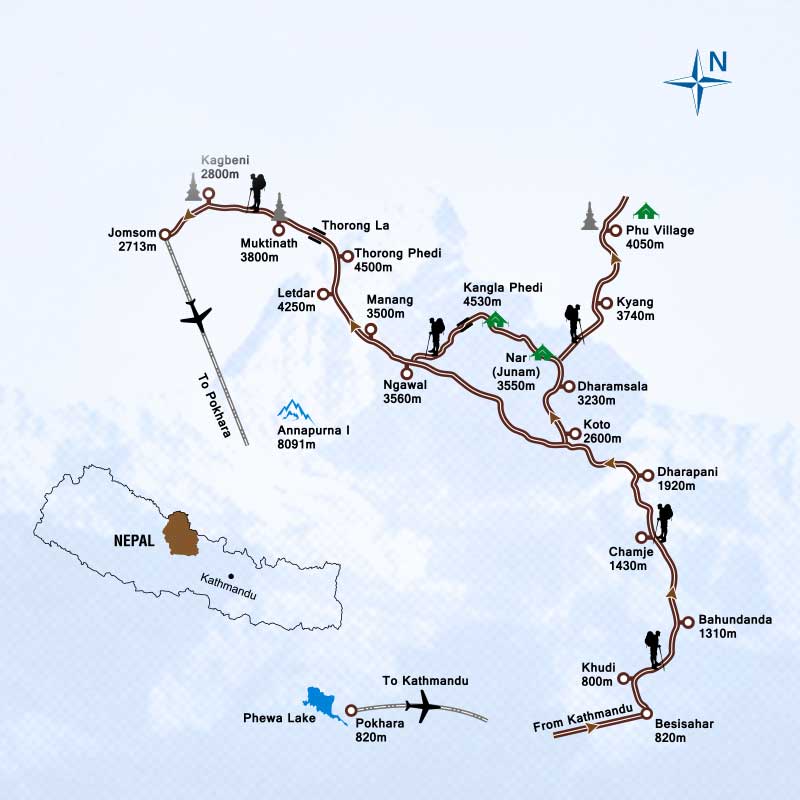
“ Join Upcoming Naar Phu Trek starting from 19-10-2026 and 30-10-2026
Note: The above information is a guide and standard template of what we provide. Our trip can be customized at your request to accommodate your specific requirements.”
| Trip Facts | |
| Destination: | Annapurna Region, Nepal |
| Trip Grade: | Moderate to Strenuous |
| Max Altitude: | 5,364 m (Everest Base Camp) |
| Best Season: | Mar–May, Sep–Nov |
| Group Size: | 2–12 |
| Start/End: | Kathmandu |
| Accommodation: | Lodge, Camping (Any One) |
Trek Further. Trek Higher. Join the Journey for 2025-2026.
Challenge the Himalaya. Expedition Bookings Open for 2025–2026.
Ready for the Summit? Join Peak Climbing Season 2025–2026.
Introducing Nepal’s Newest Adventure: Everest Base Camp Drive Trek
What Our Client Says ?
Eric Larsen – Everest Expedition Summit 2010 Autumn
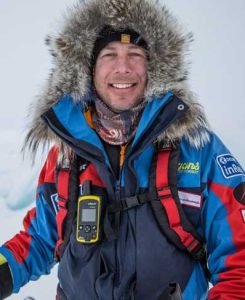
In autumn 2010, I joined the Everest Expedition organized by Himalayan Trail Blazer. Expeditions to Everest during the autumn season are rare, yet the team executed everything with outstanding professionalism, safety, and care. From the meticulous planning to the on-ground support, their expertise was evident at every step. I felt fully supported throughout the journey, and the experience remains one of the most memorable adventures of my life. I would highly recommend Himalayan Trail Blazer to anyone seeking a genuine and well-organized Himalayan expedition.”
Ryan Waters – Dhaulagiri Expedition 2010

Partnering with Himalayan Trail Blazer for the Dhaulagiri Expedition was an outstanding experience. Their logistical support, attention to detail, and deep knowledge of the Himalayan region made all the difference in ensuring the team’s safety and success. From the planning stages in Kathmandu to the final summit push, everything was handled with professionalism and genuine care. I’ve led expeditions across the world, and I can confidently say that Himalayan Trail Blazer sets a new standard in high-altitude guiding and support in Nepal.
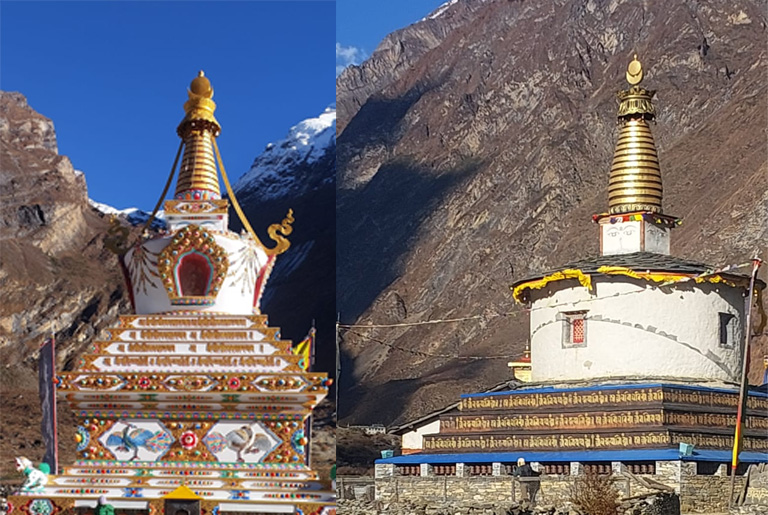
Tsum Valley Trek
Tsum Valley Manaslu Trek Trip Overview Itenary Detail Cost Include / Exclude FAQ Map The Tsum Valley Manaslu Trek is...
Read More
Lower Khumbu (Pikey Trek)
Lower Khumbu (Pikey Trek) Trip Overview Itenary Detail Cost Include / Exclude FAQ Map Following the footsteps of Hillary and...
Read More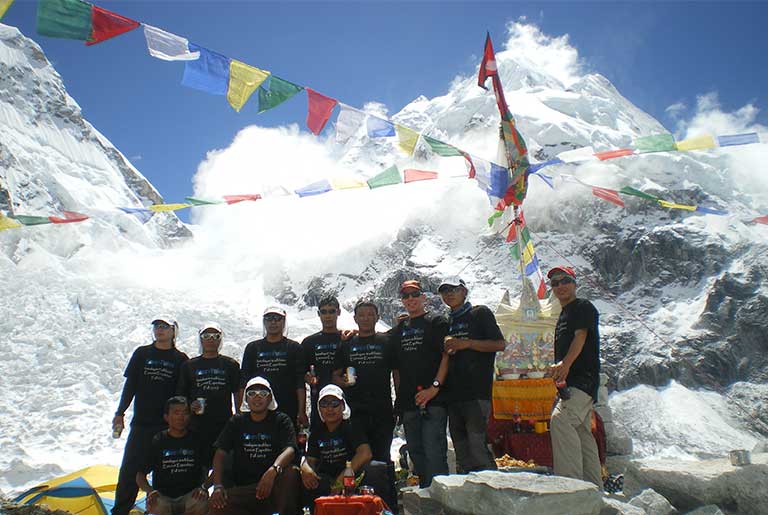
Everest Base Camp Drive Trek
Everest Base Camp Drive Optional Trip Overview Itenary Detail Cost Include / Exclude FAQ Map Following the footsteps of Hillary...
Read More
Manaslu Trek
Manaslu Trek Trip Overview Itenary Detail Cost Include / Exclude FAQ Map Trekking around Manaslu offers a unique opportunity to...
Read More
Kanchanjunga Base Camp Trek
Kanchanjunga Base Camp Trek Trip Overview Itenary Detail Cost Include / Exclude FAQ Map Kang-chen-zod-nga”, means “Five Great Treasuries of...
Read More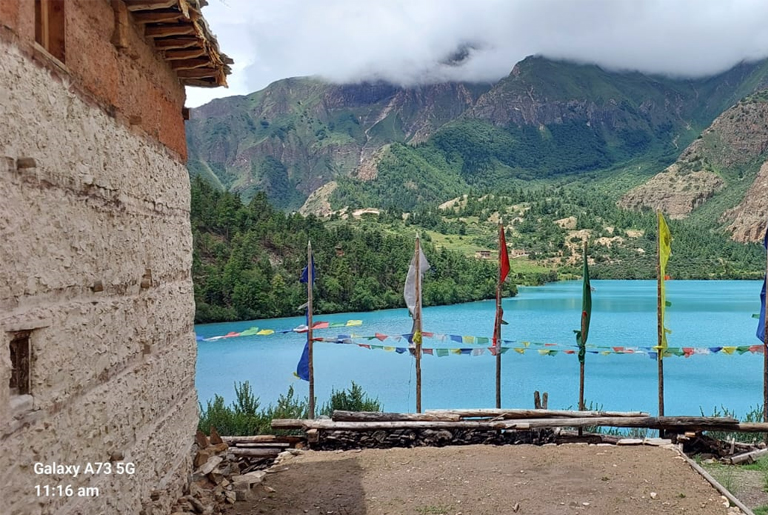
Lower Dolpo Trek
Lower Dolpo Trek Trip Overview Itenary Detail Cost Include / Exclude FAQ Map Make a rendezvous with the remote Himalaya...
Read More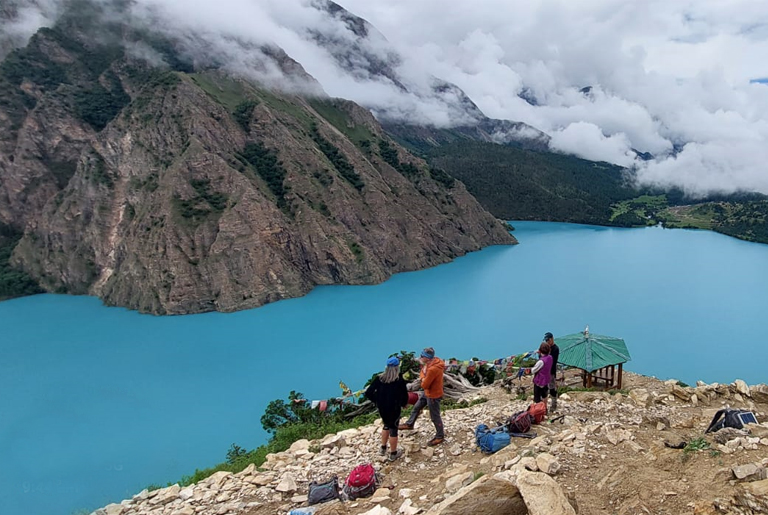
Upper Dolpo Trek
Upper Dolpo Trek Trip Overview Itenary Detail Cost Include / Exclude FAQ Map Dolpo, a land beyond the Himalayas, conjures...
Read More
Dhaulagiri Round Trek
Dhaulagiri Round Trek Trip Overview Itenary Detail Cost Include / Exclude FAQ Map Dhaulagiri 8,167m – the 7th highest mountain...
Read More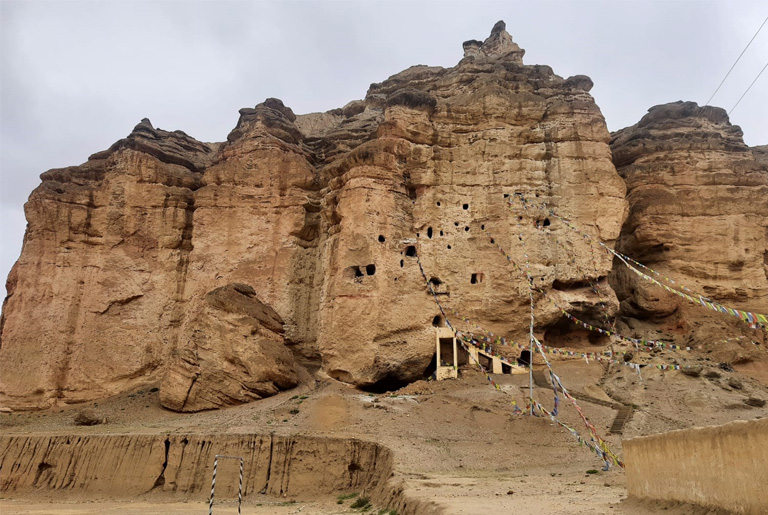
Upper Mustang Trek
Upper Mustang Trek Trip Overview Itenary Detail Cost Include / Exclude FAQ Map Trekking into Upper Mustang is a rare...
Read More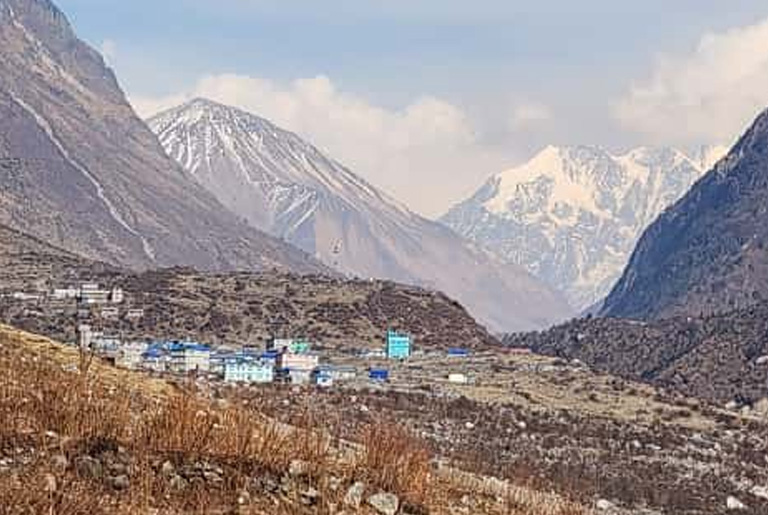
Lantang Valley Trek
Lantang Valley Trek Trip Overview Itenary Detail Cost Include / Exclude FAQ Map A trek to the Langtang valley has...
Read More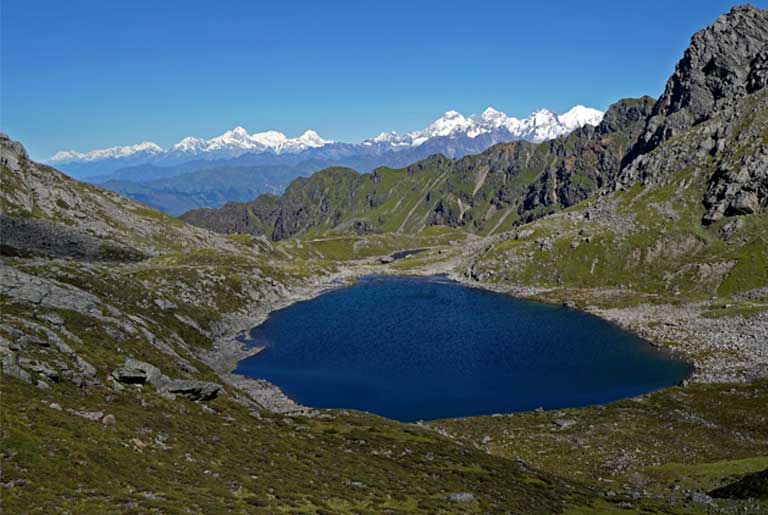
Langtang Gosaikunda Helambu Trek
Langtang Gosaikunda Helambu Trek Trip Overview Itenary Detail Cost Include / Exclude FAQ Map This classical trek combines three major...
Read More
Poon Hill Trek
Poon Hill Trek Trip Overview Itenary Detail Cost Include / Exclude FAQ Map The Annapurna Himalayan (Ghorepani and Poon Hill)...
Read More
Naar Phu Trek
Khangla & Thorang passes trek Trip Overview Itenary Detail Cost Include / Exclude FAQ Map Nar Phu, located in the...
Read More
Jomsom – Muktinath Trek
Joomsom - Muktinath Trek Trip Overview Itenary Detail Cost Include / Exclude FAQ Map The Jomsom and Muktinath trek is...
Read More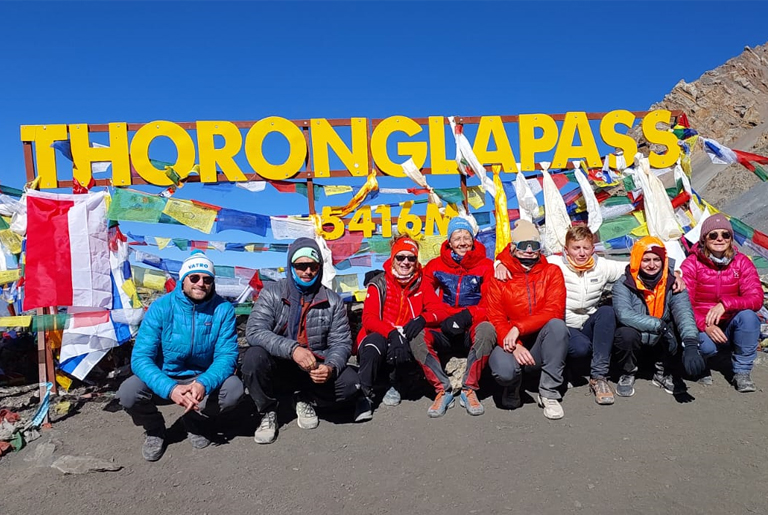
Annapurna Circuit Trek
Annapurna Circuit Trek Trip Overview Itenary Detail Cost Include / Exclude FAQ Map Since it opened to foreign trekkers in...
Read More
Annapurna Base Camp Trek
Annapurna base camp trek Trip Overview Itenary Detail Cost Include / Exclude FAQ Map Annapurna Base Camp Trek combines some...
Read More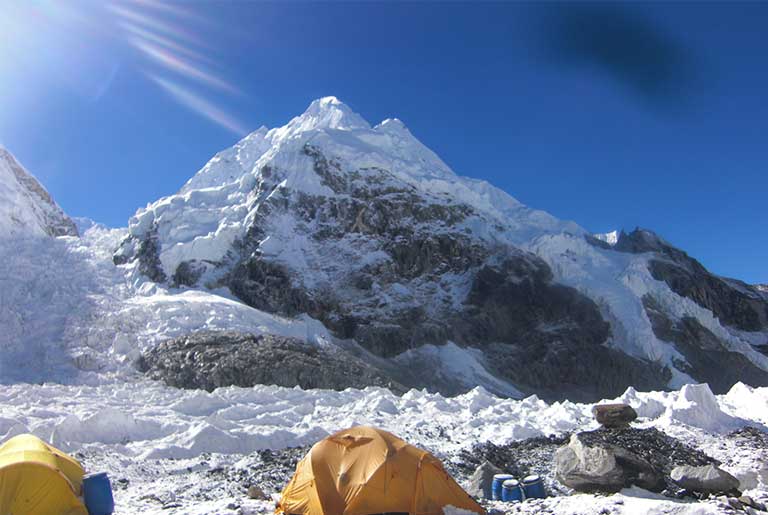
Classic Everest Trek
Classic Everest Trek Trip Overview Itenary Detail Cost Include / Exclude FAQ Map Classic Everest Trek (Jiri to Everest Base...
Read More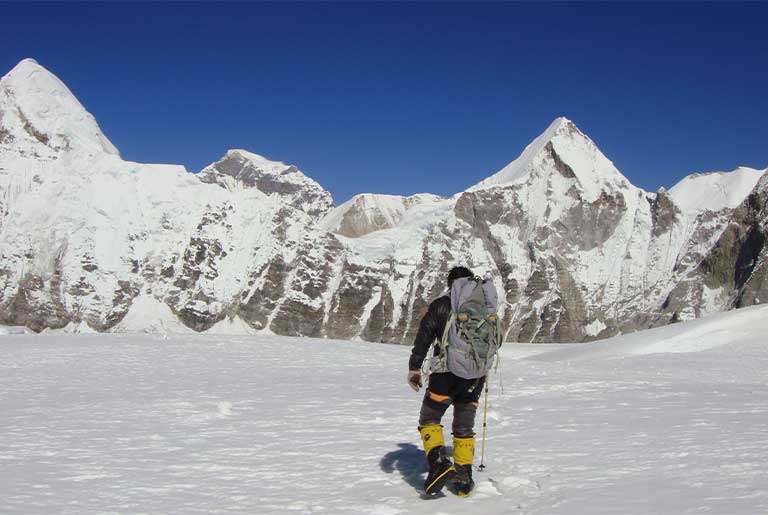
Renjo Pass Trek
Khumbu Three Passes Trek Trip Overview Itenary Detail Cost Include / Exclude FAQ Map Renjo-La pek is one of the...
Read More
Chola Pass Trek
Gokyo Chola Pass Everest Base Camp Trek Trip Overview Itenary Detail Cost Include / Exclude FAQ Map Chola Pass Trek...
Read More
Gokyo Trek
Gokyo Trek Trip Overview Itenary Detail Cost Include / Exclude FAQ Map Trekking around Gokyo valley is considered a traditional...
Read More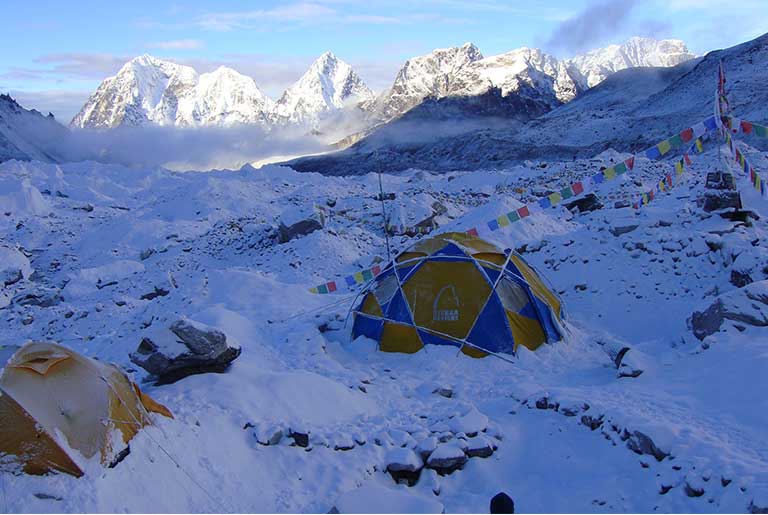
Everest Panorama Trek
Everest Panaroma Trek Trip Overview Itenary Detail Cost Include / Exclude FAQ Map This easy trek in the foothills of...
Read More
Everest Base Camp Trek
Everest Base Camp Trek Trip Overview Itenary Detail Cost Include / Exclude FAQ Map Following the footsteps of Hillary and...
Read More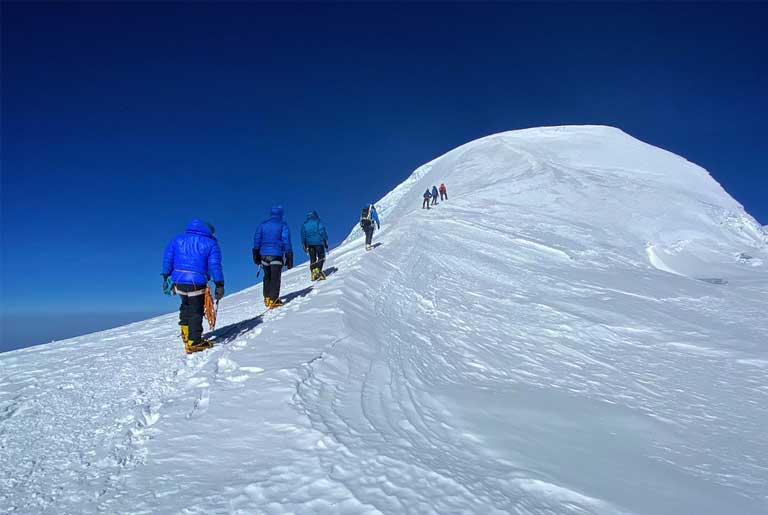
Mera Peak
Mera Peak Trip Overview Itenary Detail Cost Include / Exclude FAQ Map Mera Peak is the highest trekking peak in
Read More




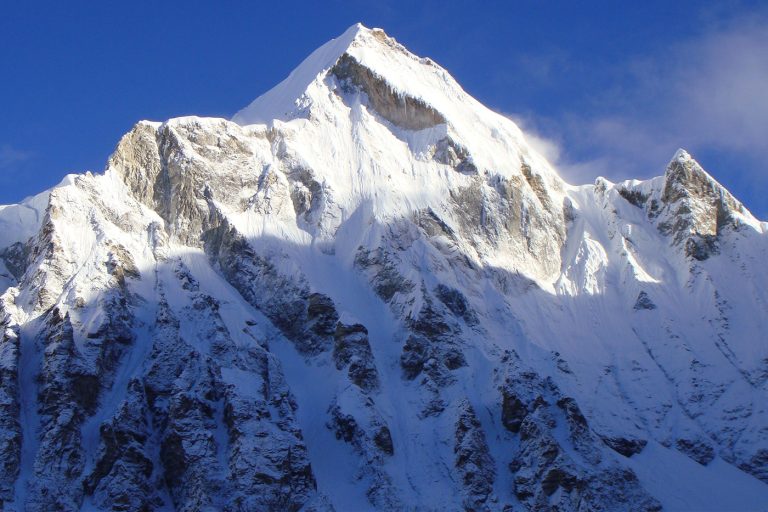
Everest Expedition 2015 Spring
Everest Expedition 2015 Spring Descriptions Himalayan Trail Blazer (HTB) has long been dedicated to organizing world-class climbing expeditions in the
Read More
Manaslu Expeditino, 2014, October
Manaslu Expedition, 2014, October Descriptions Himalayan Trail Blazer has long been recognized for its expertise in leading climbers through the
Read More
Manaslu Expeditino, 2013, October
Manaslu Expedition, 2013, October Descriptions Himalayan Trail Blazer Trekking & Expedition proudly announced the successful conclusion of its Manaslu Expedition
Read More
Manaslu Expedition, 2012, October
Manaslu Expedition, 2012, October Descriptions Manaslu, towering at 8,163 meters, is the eighth-highest mountain in the world. Nestled in the
Read More
Dhaulagiri Expedition 2012, March till
Dhaulagiri Expedition 2012, March till May - Organized by Himalayan Trail Blazer Descriptions In the spring of 2012, Himalayan Trail
Read More
Manaslu Expedition, 2011, October
Manaslu Expedition, 2011, October Descriptions In October 2011, Himalayan Trail Blazer organized a remarkable expedition to Manaslu, led by veteran
Read More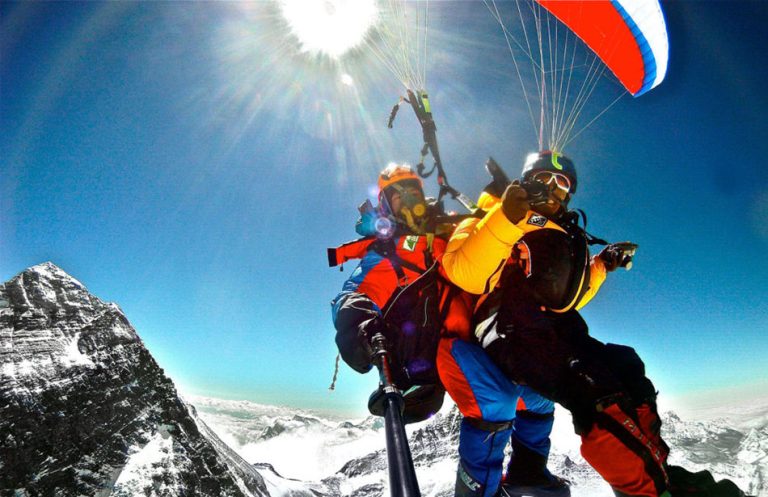
Summit to Sea, 2011 Spring
Summit to Sea, 2011 Spring https://youtu.be/pZ46cuM62ZE?si=oxNaAtznxP38eIK6 Descriptions On June 27, 2011, with the support of Himalayan Trail Blazer, adventurers Mr.
Read More
Everest Expedition via South –
Everest Expedition via South - 2010, October (SAVE THE POLES) -- Eric Larsen Descriptions In Support with Himalayan Trail Blazer,
Read More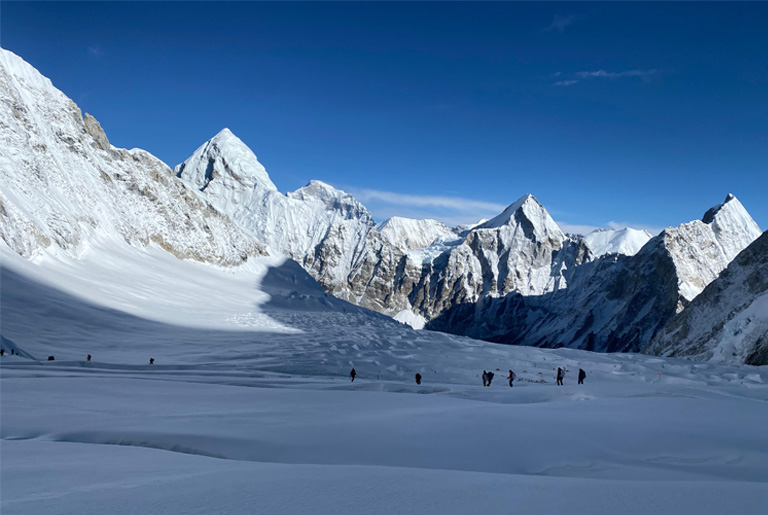
Mt. Lhotse Expedition
Mt. Lhotse Expedition (8516m) Trip Overview Itenary Detail Cost Include / Exclude FAQ Map “Lhotse” which means south peaks is
Read More
Tharpa Chuli Peak
Tharpa Chuli Peak Trip Overview Itenary Detail Cost Include / Exclude FAQ Map Tharphu Chuli (locally known as), Tent Peak
Read More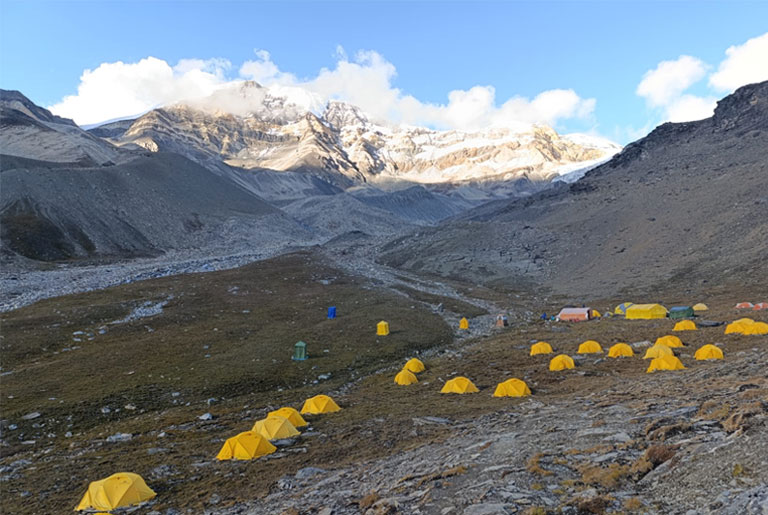
Chulu Far-East Peak
Chulu East Peak Trip Overview Itenary Detail Cost Include / Exclude FAQ Map These peaks are part of the Manang
Read More
Pisang Peak
Pissang Peak Trip Overview Itenary Detail Cost Include / Exclude FAQ Map Pisang Peak stands at elevation of 6091 meters
Read More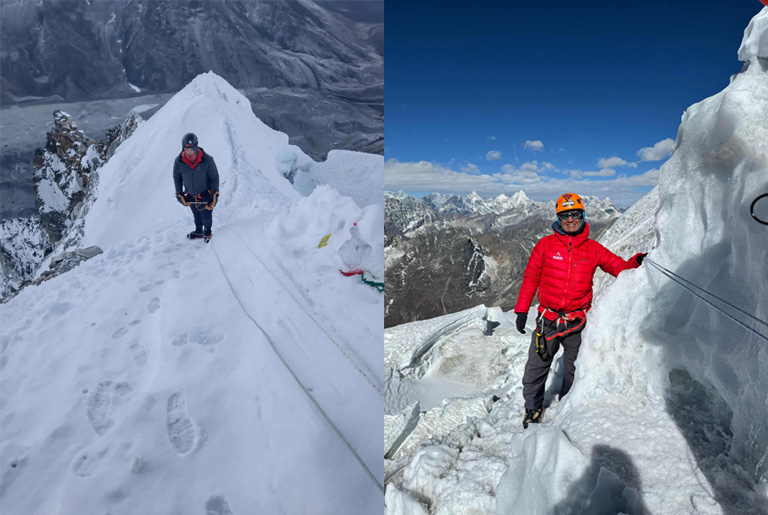
Island Peak
Island Peak Trip Overview Itenary Detail Cost Include / Exclude FAQ Map Island Peak is 6187 meters high and one
Read More
Lobuche Peak
Lobuche Peak Trip Overview Itenary Detail Cost Include / Exclude FAQ Map Lobuche Peak 6119m is one of the popular
Read More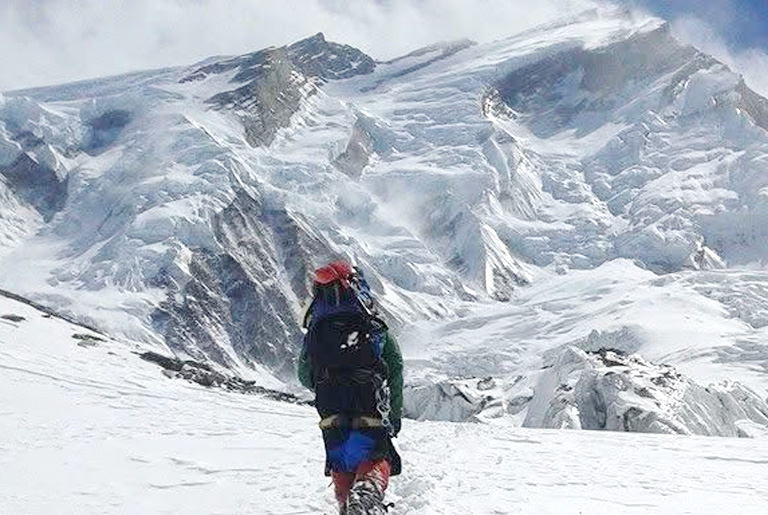
Mt. Annapurna I Expedition
Mt. Annapurna I Expedition (8091m) Trip Overview Itenary Detail Cost Include / Exclude FAQ Map Annapurna is an enormous Himalayan
Read More
Mt. Manaslu Expedition (8163m)
Mt. Manaslu Expedition (8163m) Trip Overview Itenary Detail Cost Include / Exclude FAQ Map Mt. Manaslu (8,163m / 26,781ft) Located
Read More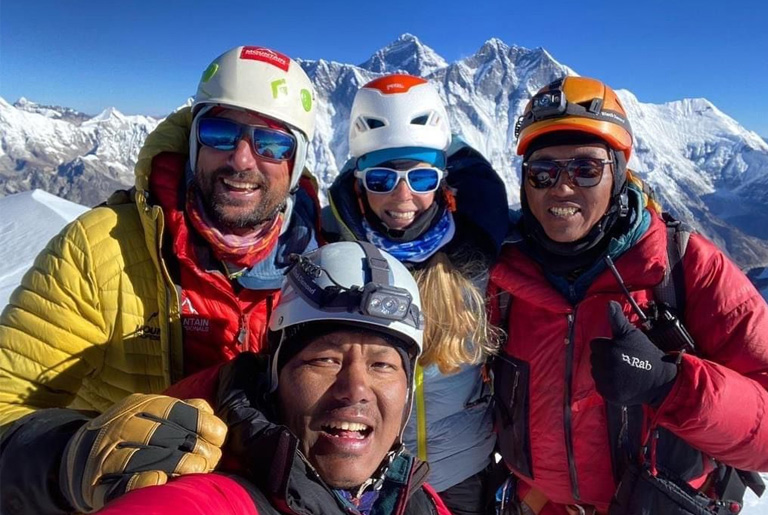
Mt. Amadablam Expedition (6812m)
Mt. Amadablam Expedition (6812m) Trip Overview Itenary Detail Cost Include / Exclude FAQ Map Mt. Ama Dablam expedition has long
Read More
Mt. Everest Expedition (8848m) via
Mt. Everest Expedition (8848m) via South Trip Overview Itenary Detail Cost Include / Exclude FAQ Map The highest summit alone
Read More
Manaslu Trek
Manaslu Trek Trip Overview Itenary Detail Cost Include / Exclude FAQ Map Trekking around Manaslu offers a unique opportunity to
Read More



Dhaulagiri Round Trek
Dhaulagiri Round Trek Trip Overview Itenary Detail Cost Include / Exclude FAQ Map Dhaulagiri 8,167m – the 7th highest mountain
Read More




Naar Phu Trek
Khangla & Thorang passes trek Trip Overview Itenary Detail Cost Include / Exclude FAQ Map Nar Phu, located in the
Read More
Jomsom – Muktinath Trek
Joomsom - Muktinath Trek Trip Overview Itenary Detail Cost Include / Exclude FAQ Map The Jomsom and Muktinath trek is
Read More
Annapurna Circuit Trek
Annapurna Circuit Trek Trip Overview Itenary Detail Cost Include / Exclude FAQ Map Since it opened to foreign trekkers in
Read More



Chola Pass Trek
Gokyo Chola Pass Everest Base Camp Trek Trip Overview Itenary Detail Cost Include / Exclude FAQ Map Chola Pass Trek
Read More
Gokyo Trek
Gokyo Trek Trip Overview Itenary Detail Cost Include / Exclude FAQ Map Trekking around Gokyo valley is considered a traditional
Read More
Everest Panorama Trek
Everest Panaroma Trek Trip Overview Itenary Detail Cost Include / Exclude FAQ Map This easy trek in the foothills of
Read More





